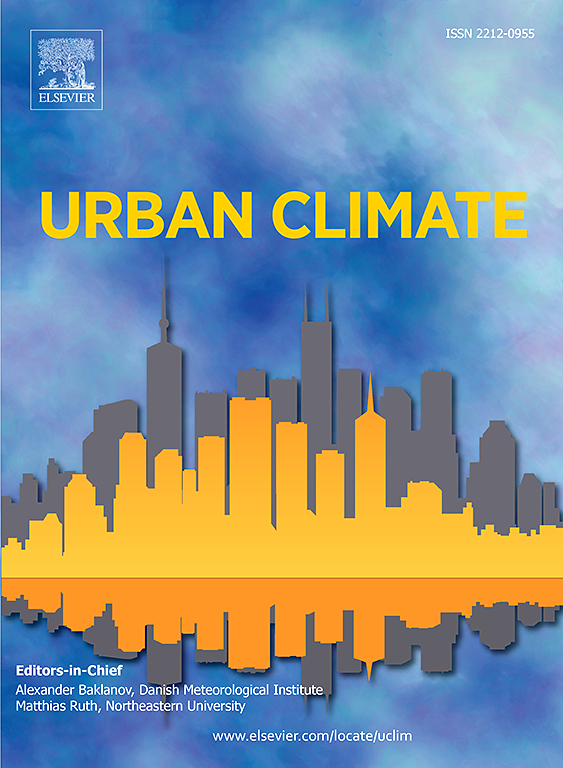塞浦路斯尼科西亚热浪期间室外热应力和建筑能耗的适应和缓解
IF 6
2区 工程技术
Q1 ENVIRONMENTAL SCIENCES
引用次数: 0
摘要
东地中海和中东地区的城市面临气温上升和热浪加剧的问题,城市热岛效应放大了这些问题。这些挑战对人类健康、农业和水-能源关系构成重大威胁,强调需要在城市规模上进行深入分析并制定有效的缓解战略。为了满足这一需求,我们对2021年7月23日至8月10日塞浦路斯尼科西亚热浪期间19天内7项干预措施的效果进行了建模。我们使用天气研究与预报(WRF)模型结合多层建筑能源参数化/建筑能源模型(BEP/BEM)方案评估了三个关键结果:2米空气温度、室外热应力和空调能源使用。我们的研究结果表明,在分析期间,城市树木是最有效的单一干预措施,减少了约46%的能源消耗,减少了20-25 h的热应力度小时。凉爽屋顶和城市树木的结合被证明是最有效的,减少了50%以上的能源消耗,白天将200米的气温降低了1.2°C。通过光伏板和城市树木的整合,出现了一种有希望的适应性缓解策略,这种策略减少了热应力,同时产生的能量大大有助于满足冷却需求。这些干预措施的效果因城市几何形状而异,在建筑高度和密度中等的地区效益最大。这些发现为在半干旱地区制定城市气候适应能力战略提供了指导,强调了因地制宜地应用热适应和缓解措施的重要性。本文章由计算机程序翻译,如有差异,请以英文原文为准。
Adaptation and mitigation of outdoor heat stress and building energy consumption during a heat wave in Nicosia, Cyprus
Cities in the Eastern Mediterranean and Middle East region face rising temperatures and intensifying heatwaves that are amplified by the urban heat island effect. These challenges pose significant threats to human health, agriculture, and the water–energy nexus, emphasizing the need for in-depth analysis and effective mitigation strategies at the urban scale. To address this need, we model the effects of seven interventions over 19 days, from July 23rd to August 10th, 2021, during a heatwave in Nicosia, Cyprus. We assess three key outcomes using the Weather Research and Forecasting (WRF) model coupled with the multilayer Building Energy Parameterization/Building Energy Model (BEP/BEM) scheme: 2m air temperature, outdoor heat stress, and air-conditioning energy use. Our results demonstrate that urban trees are the most effective single intervention, reducing energy consumption by approximately 46% and decreasing heat stress-degree hours by 20–25 h over the analyzed period. The combined implementation of cool roofs and urban trees proved to be the most effective overall, reducing energy consumption by over 50% and lowering 2m air temperatures by up to 1.2 °C during the day. A promising adaptive mitigation strategy emerged through the integration of photovoltaic panels and urban trees, which reduced heat stress while generating energy that significantly contributes to cooling demands. The efficacy of these interventions varied with urban geometry, with maximum benefits in areas characterized by medium building heights and densities. These findings offer guidance for developing urban climate resilience strategies in semi-arid regions, underscoring the importance of location-specific application of heat adaptation and mitigation measures.
求助全文
通过发布文献求助,成功后即可免费获取论文全文。
去求助
来源期刊

Urban Climate
Social Sciences-Urban Studies
CiteScore
9.70
自引率
9.40%
发文量
286
期刊介绍:
Urban Climate serves the scientific and decision making communities with the publication of research on theory, science and applications relevant to understanding urban climatic conditions and change in relation to their geography and to demographic, socioeconomic, institutional, technological and environmental dynamics and global change. Targeted towards both disciplinary and interdisciplinary audiences, this journal publishes original research papers, comprehensive review articles, book reviews, and short communications on topics including, but not limited to, the following:
Urban meteorology and climate[...]
Urban environmental pollution[...]
Adaptation to global change[...]
Urban economic and social issues[...]
Research Approaches[...]
 求助内容:
求助内容: 应助结果提醒方式:
应助结果提醒方式:


